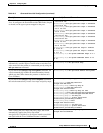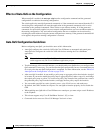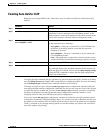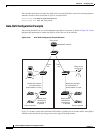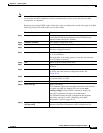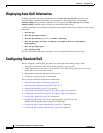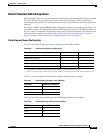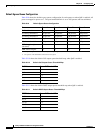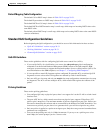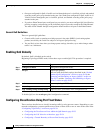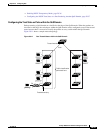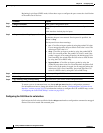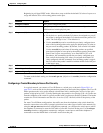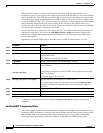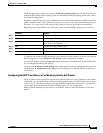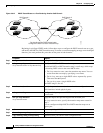
29-31
Catalyst 2960 Switch Software Configuration Guide
78-16881-01
Chapter 29 Configuring QoS
Configuring Standard QoS
Default Mapping Table Configuration
The default CoS-to-DSCP map is shown in Table 29-12 on page 29-51.
The default IP-precedence-to-DSCP map is shown in Table 29-13 on page 29-52.
The default DSCP-to-CoS map is shown in Table 29-14 on page 29-54.
The default DSCP-to-DSCP-mutation map is a null map, which maps an incoming DSCP value to the
same DSCP value.
The default policed-DSCP map is a null map, which maps an incoming DSCP value to the same DSCP
value (no markdown).
Standard QoS Configuration Guidelines
Before beginning the QoS configuration, you should be aware of this information in these sections:
• “QoS ACL Guidelines” section on page 29-31
• “Policing Guidelines” section on page 29-31
• “General QoS Guidelines” section on page 29-32
QoS ACL Guidelines
These are the guidelines with for configuring QoS with access control lists (ACLs):
• If you use QoS ACLs for classification, you can use the sdm prefer qos global configuration
command to set the Switch Database Management (SDM) feature to the QoS template. SDM
configures system resources to support the maximum number of access control entries (ACEs). For
more information on the SDM templates, see Chapter 7, “Configuring SDM Templates.”
• It is not possible to match IP fragments against configured IP extended ACLs to enforce QoS. IP
fragments are sent as best-effort. IP fragments are denoted by fields in the IP header.
• Only one ACL per class map and only one match class-map configuration command per class map
are supported. The ACL can have multiple ACEs, which match fields against the contents of the
packet.
Policing Guidelines
These are the policing guidelines:
• You configure QoS only on physical ports; there is no support for it at the VLAN or switch virtual
interface level.
• The port ASIC device, which controls more than one physical port, supports 256 policers (255
policers plus 1 no policer). The maximum number of policers supported per port is 64. Policers are
allocated on demand by the software and are constrained by the hardware and ASIC boundaries. You
cannot reserve policers per port; there is no guarantee that a port will be assigned to any policer.
• Only one policer is applied to a packet on an ingress port. Only the average rate and committed burst
parameters are configurable.
• You can set the policing rate only in 1-Mbps increments. If you try to set a policing rate at less
than1 Mbps, the switch prompts you for a correct value.



